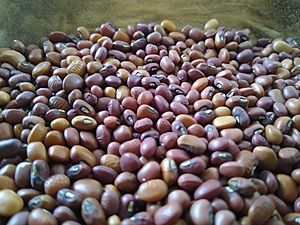Sea Island red pea facts for kids
Quick facts for kids Sea Island red pea |
|
|---|---|

Diversity among Sea Island red pea phenotypes displayed.
|
|
| Species | Vigna unguiculata (L.) Walp. |
| Cultivar group | 'Unguiculata' |
| Cultivar | Sea Island red pea |
| Marketing names | Sapelo island red peas, Sapelo red pea and Geechee red peas |
| Origin | Sapelo Island and the Sea Islands |
The Sea Island red pea is a special type of cowpea. It's an heirloom plant, meaning it's a very old variety passed down through generations. This pea comes from the Gullah corridor in the Sea Islands. It's a super important part of Gullah cooking and has even been added to the Ark of Taste, which lists foods that are important to protect.
Contents
History of the Sea Island Red Pea
Where Cowpeas Began
Cowpeas, which include the Sea Island red pea, first grew in West Africa. Scientists believe this is where they were first grown by people. Old burnt cowpea remains have been found in Ghana from thousands of years ago. By the 1600s, cowpeas started to be grown in the New World (the Americas). They arrived when people were brought across the Atlantic Ocean. These peas were used as food for many people.
How Sea Island Red Peas Came to the Sea Islands
The Sea Island red peas came to the Sea Islands from the Mende tribe in what is now Sierra Leone. Between 1750 and 1775, many people from West Africa were brought to the Sea Islands. They came from places like Guinea, Guinea-Bissau, Ivory Coast, Sierra Leone, and Liberia. These people were very skilled at growing a special kind of rice called Carolina gold rice. They also brought their knowledge of growing plants like the Sea Island red pea.
Keeping the Culture Alive Today
Over time, many Gullah people have moved away from their traditional homes to find new opportunities. This has led to fewer people speaking the Gullah language. Also, some Gullah communities have had to move from their homes because of new resorts and golf courses. Because of these changes, the Sea Island red pea has become a way to help keep the Gullah culture strong and alive for the future. It's a symbol of their heritage.
Growing Sea Island Red Peas
Since the Sea Island red pea is a landrace, its seeds can look a little different from each other. They might have slightly different colors or sizes.
You should plant these peas before the first frost, usually between late May and mid-July. They are climbing plants, so they need something to grow on, like a trellis. Plant the seeds about 1 inch deep and about 4 inches apart. These peas are tough! They can grow well even in poor soil. Plus, they help make the soil healthier by adding nitrogen back into it. To make sure they don't mix with other types of cowpeas, plant them at least 20 feet away. You can save the seeds for next year when the pea pods are dry and crispy.
Cooking with Sea Island Red Peas
You can use Sea Island red peas in many ways, just like other cowpeas or black-eyed peas. They are great for making dishes like hoppin' John, acarajé, or waakye.
A famous American chef named Sean Brock says that the traditional hoppin' John was made with Carolina Gold rice and Sea Island red peas. He has worked with farmers to bring these special ingredients back to stores.
Traditionally, Gullah people would cook these peas in a dish called perloo. They also made a popular meal called red peas and rice.

